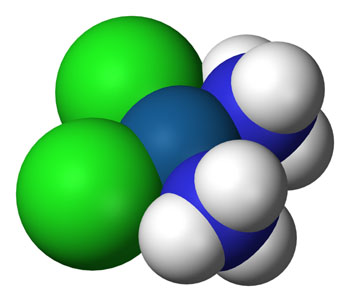Drug Resistance in Cancer Cells Linked to Changes in MicroRNA Expression
By LabMedica International staff writers
Posted on 09 Jun 2016
Cancer researchers have linked development of resistance to chemotherapy in pancreatic cancer cells to the downregulation of a specific microRNA (miRNA).Posted on 09 Jun 2016
MicroRNAs are a class of about 20 nucleotides-long RNA fragments that block gene expression by attaching to molecules of messenger RNA in a fashion that prevents them from transmitting the protein synthesizing instructions they had received from the DNA. With their capacity to fine-tune protein expression via sequence-specific interactions, miRNAs help regulate cell maintenance and differentiation.

Image: A three-dimensional model of the cisplatin molecule (Photo courtesy of Wikimedia Commons).
Investigators at the Georgia Institute of Technology (Atlanta, USA) adapted a line of pancreatic cancer cells (BxPC3) to increasing levels of the chemotherapy drug cisplatin. Following each cycle of exposure, surviving cells were cultured and then exposed to a higher level of the drug. After 20 treatment cycles, the resulting cell line had a resistance to cisplatin that was 15 times greater than that of the original cancer cells.
The investigators then compared levels of more than 2000 miRNAs in the cisplatin-resistant cell line (BxPC3-R) to those in the original cisplatin-sensitive parental (BxPC3) cell line.
They reported in the May 27, 2016, online edition of the journal Cancer Gene Therapy that the acquired drug resistance was accompanied by significant changes in the expression of 57 miRNAs, of which 23 were downregulated and 34 were upregulated. Employing a hidden Markov model (HMM) algorithm, they identified downregulation of miR-374b as likely being directly involved in acquisition of the drug-resistant phenotype.
This finding was confirmed by inducing overexpression of miR-374b in the resistant BxPC3-R cells, which restored cisplatin sensitivity to levels approaching those displayed by the BxPC3 parental cells.
"These cells have acquired resistance to the drug, and we have found a microRNA that seems to be playing a major role," said senior author Dr. John McDonald, professor of biology at the Georgia Institute of Technology. "We have shown that we can bring sensitivity to drugs back by restoring levels of miR374b, but there may be other miRNAs that will work equally as well. Just as there are multiple pathways to establish cancer and chemoresistance, there may be multiple pathways to restore chemosensitivity, as well."
"We were specifically interested in what role miRNAs might play in developing drug resistance in these cancer cells," said Dr. McDonald. "By increasing the levels of the miRNA governing the suite of genes we identified, we increased the cells' drug sensitivity back to what the baseline had been, essentially undoing the resistance. This would suggest that for patients developing chemotherapy resistance, we might one day be able to use miRNAs to restore the sensitivity of the cancer cells to the drugs."
Related Links:
Georgia Institute of Technology













